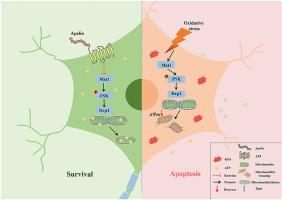Apelin通过抑制Mst1-JNK-Drp1信号通路调节线粒体动力学,从而减少脊髓损伤后的神经细胞凋亡。
IF 4.4
3区 医学
Q2 BIOCHEMISTRY & MOLECULAR BIOLOGY
引用次数: 0
摘要
在脊髓损伤的继发性损伤阶段,线粒体功能障碍会导致 ATP 生成减少、ROS 生成增加,并激活线粒体介导的细胞凋亡信号通路。这最终会加剧神经元的死亡,促进损伤的发展。Apelin是一种由APLN基因产生的多肽,在治疗脊髓损伤方面前景看好。本研究旨在探讨 Apelin 如何通过影响线粒体动力学来保护脊髓损伤后的神经元。结果表明,Apelin 能够减少 PC12 细胞线粒体分裂,增强线粒体膜电位,提高抗氧化能力,促进过量 ROS 的清除,并最终减少细胞凋亡。此外,Apelin 在脊髓受损部位的神经元中过表达,有助于减少线粒体分裂、提高抗氧化能力、增加 ATP 生成、减少细胞凋亡、促进脊髓形态修复、维持 nissl 体的数量以及增强脊髓下降通路的信号转导。Apelin通过抑制Mst1-JNK-Drp1信号通路发挥保护作用。综上所述,我们的研究进一步提高了Apelin治疗脊髓损伤的效果,揭示了Apelin通过维持线粒体平衡保护脊髓损伤后受损神经元的机制,为Apelin治疗脊髓损伤提供了新的治疗机制。本文章由计算机程序翻译,如有差异,请以英文原文为准。

Apelin regulates mitochondrial dynamics by inhibiting Mst1-JNK-Drp1 signaling pathway to reduce neuronal apoptosis after spinal cord injury
In the secondary injury stage of spinal cord injury, mitochondrial dysfunction leads to decreased ATP production, increased ROS production, and activation of the mitochondria-mediated apoptosis signaling pathway. This ultimately intensifies neuronal death and promotes the progression of the injury. Apelin, a peptide produced by the APLN gene, has demonstrated promise in the treatment of spinal cord injury. The aim of this study was to investigate how Apelin protects neurons after spinal cord injury by influencing the mitochondrial dynamics. The results showed that Apelin has the ability to reduce mitochondrial fission, enhance the mitochondrial membrane potential, improve antioxidant capacity, facilitate the clearance of excess ROS, and ultimately decrease apoptosis in PC12 cells. Moreover, Apelin is overexpressed in neurons in the damaged part of the spinal cord, contributing to reduce mitochondrial fission, improve antioxidant capacity, increase ATP production, decrease apoptosis, promote spinal cord morphological repair, maintain the number of nissl bodies, and enhance signal transduction in the descending spinal cord pathway. Apelin exerts its protective effect by inhibiting the Mst1-JNK-Drp1 signaling pathway. In summary, our study further improved the effect of Apelin in the treatment of spinal cord injury, revealed the mechanism of Apelin in protecting damaged neurons after spinal cord injury by maintaining mitochondrial homeostasis, and provided a new therapeutic mechanism for Apelin in spinal cord injury.
求助全文
通过发布文献求助,成功后即可免费获取论文全文。
去求助
来源期刊

Neurochemistry international
医学-神经科学
CiteScore
8.40
自引率
2.40%
发文量
128
审稿时长
37 days
期刊介绍:
Neurochemistry International is devoted to the rapid publication of outstanding original articles and timely reviews in neurochemistry. Manuscripts on a broad range of topics will be considered, including molecular and cellular neurochemistry, neuropharmacology and genetic aspects of CNS function, neuroimmunology, metabolism as well as the neurochemistry of neurological and psychiatric disorders of the CNS.
 求助内容:
求助内容: 应助结果提醒方式:
应助结果提醒方式:


